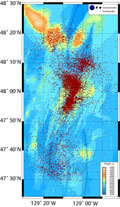investigations
background
Linkages Between Earthquakes and Microbial Productivity
The seismic component of VISIONS ‘05 cruise forms part of a multidisciplinary project funded by the W. M. Keck Foundation to investigate the linkages between seismic deformation of the oceanic crust, venting of nutrient-rich fluids at the seafloor, and microbial productivity. The primary seismic objective of this expedition is to recover and redeploy a network of sophisticated seismometers that, for past two years, have been monitoring small earthquakes and volcanic tremors in the vicinity of the vent fields on the Endeavour segment of the Juan de Fuca Ridge. In addition, several seismometers that were deployed last year on the Nootka Fault and Explorer plate will be recovered.
A Unique Seafloor Network of Seismometers
The seismometers used for the Keck Endeavour network were developed by the Monterey Bay Aquarium Research Institute (MBARI). The network is unique amongst seafloor networks, in that all the seismometers are deployed carefully with a remotely operated vehicle (ROV) below the seafloor rather than as free-fall instruments that fall haphazardly onto the seabed. The network is also the first on a mid-ocean ridge to include a buried broadband seismometer. This instrument can record the full range of seismic signals expected from a mid-ocean ridge volcanic/hydrothermal system and facilitates a wide variety of studies of regional earthquakes. At present, the seismometers are deployed to operate autonomously. Each year, they must be visited by an ROV to recover the data and replace the batteries. In the future, scientists hope to connect the seismic network to the NEPTUNE cabled observatory which will provide power and access to the data in real time.
13,000 Earthquakes in One Year
The first year of data from the Endeavour network was recovered in the summer of 2004 and is of excellent quality. In Fall 2004, eight enthusiastic undergraduates participated in an intensive research apprenticeship class at the University of Washington’s Friday Harbor Laboratories and worked with seismologists from the University of Washington and the University of Oregon to complete a preliminary analysis of the data. They located nearly 13,000 earthquakes on the Juan de Fuca Ridge, including over 3,000 beneath the Endeavour vent fields. Since that time ongoing analysis has focused on applying a variety of techniques to further study the earthquakes beneath the vent fields.
Earthquakes and Hydrothermal Circulation
These earthquakes are associated the hydrothermal reaction zone (link to Chemistry of Vent Fluids), a region immediately overly the magma chamber at a depth of 2-3 km below the seafloor, where seawater circulating through the crust heats up, reacts with the surrounding rock, and rises rapidly to the hydrothermal vents. These earthquakes play a critical role in hydrothermal circulation since they produce the cracks through which the fluids circulate. Without continued fracturing, the cracks would clog up with the alteration minerals produced by the high-temperature chemical reactions between the hydrothermal fluid and rock.
Two Possible Causes
The earthquakes in the reaction zone may be a direct result of the ongoing separation of the two tectonic plates to either side of the Juan de Fuca Ridge or they may be caused by the hydrothermal circulation itself – when seawater cools hot rock it can contract and fracture just like an ice cube placed into a glass of warm water. By studying the distribution and characteristics of earthquakes in this region, scientists hope to distinguish between these two alternative ideas. In addition, temporal changes in the patterns of seismicity can be correlated with changes in the properties of the hydrothermal vent fluids to better understand the plumbing of the hydrothermal system.
Comparing Data
During the past year, the US Navy’s Sound Surveillance System (SOSUS) network of underwater hydrophones has detected several significant swarms on the Endeavour segment and Seismic Activity. During its second year, the Keck seismic network has likely recorded an a very large number of earthquakes and Keck investigators are looking forward to getting these data during the VISIONS ‘05 cruise.




